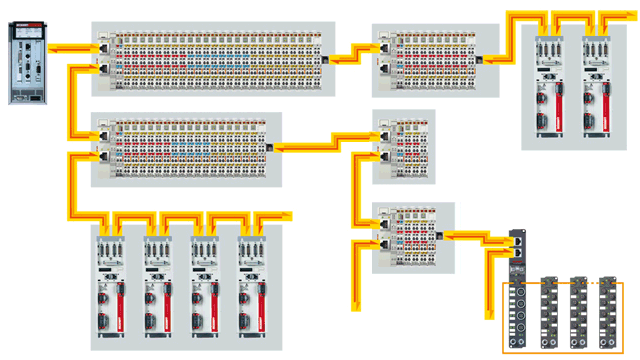System structure

In analogy to the Beckhoff Bus Terminals the EtherCAT terminal system is a modular I/O system consisting of electronic terminal blocks. An I/O station consists of an EtherCAT coupler and almost any number of terminals. Since up to 65535 devices can be connected, the size of the network is almost unlimited.
EtherCAT is designed for operation without switch. In this case the EK1100 coupler is used. For applications requiring a switch Beckhoff will shortly provide a solution in the form of the EK1000 that can process the EtherCAT UDP protocol in passing.
The electronic terminal blocks are attached to the EtherCAT coupler. The contacts are made as the terminal clicks into place, without any other manipulation. This means that each electronic terminal block can be individually exchanged. It can be placed on a standard mounting rail.
Suitable EtherCAT terminals are available for common digital and analog signal types encountered in the world of automation. Fieldbus devices, e.g. for PROFIBUS, CANopen or DeviceNet, are integrated via local fieldbus master/slave terminals. Removal of the fieldbus master saves PCI slots in the PC. Any Ethernet devices can be connected decentralised via switch terminals.
The fine granularity of the EtherCAT terminals enables bit-precise composition of the required I/O channels. The digital EtherCAT terminals are designed as 2-, 4-, or 8-channel terminals. The standard analog signals of ± 10 V, 0 ... 10 V, 0 ... 20 mA and 4 ... 20 mA are all available as 1-, 2-, 4-, and 8-channel variants within a standard housing. The EtherCAT Terminal system offers different connection options for optimum adaptation to the respective application. The ELxxxx EtherCAT terminals include electronics and connection level in a single enclosure. The ESxxxx type EtherCAT terminals feature a pluggable connection level. The ES series Bus Terminals enable the complete wiring to be removed as a plug connector from the top of the housing for servicing.
Free choice of topology – maximum wiring flexibility: with or without switch, line or tree topologies, can be freely selected and combined. Address assignment is automatic, no IP address setting is required.